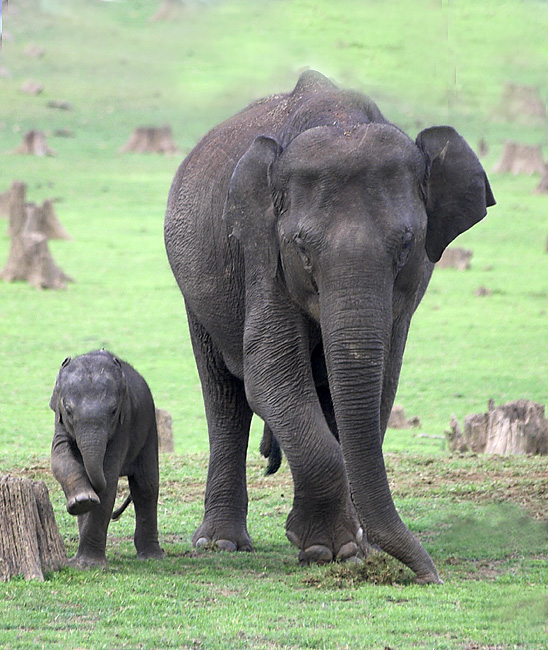| Elephant Landscapes | Range state/s | Area of the landscape (sq km) |
| East–Central Landscape | West Bengal, Jharkhand, Orissa, Chattisgarh | 17,092.3 |
| Kameng–Sonitpur Landscape | Arunachal Pradesh, Assam | 3,312 |
| Eastern South Bank Landscape | Assam, Arunachal Pradesh | 2,894.5 |
| Kaziranga–Karbi Anglong–Intanki Landscape | Assam, Nagaland | 6,212 |
| North Bengal–Greater Manas Landscape | Assam, West Bengal | 3,578 |
| Meghalaya Landscape | Meghalaya | 3,831 |
| Bramhagiri–Nilgiri–Eastern Ghat Landscape | Karnataka, Kerala, Tamil Nadu, Andhra Pradesh | 15,320 |
| Anamalai–Nelliampathy–High Range Landscape | Tamil Nadu, Kerala | 5,185 |
| Periyar–-Agasthyamalai | Kerala, Tamil Nadu | 4,991 |
| North–Western Landscape | Uttarakhand, Uttar Pradesh | 6,149 |
Other serious concerns
- Another critical issue addressed is the way elephant habitats are managed in the name of ‘habitat improvement’. The report has set guidelines on management of surface water, forest road construction, and soil and moisture conservation activities in elephant habitats. This is an effort to inculcate scientific management of habitats and also prevent ‘leakage’ of conservation funds.
- The opening of an ivory trade finds no support in the report as it states that ‘no rationale, whether ecological, economic and ethical, can justify international ivory trade’. Expressing unstinted support for wildlife conservation, the report states ‘in India species do not always have to pay to survive’. This should answer questions of culling, trophy hunting and other similar conservation paradigms.
- Issues that are perhaps ubiquitous to most tropical countries such as improving enforcement effectiveness and staff recruitment at lower levels also find place in the report.
Education and outreach
- Breaking the domain of conservation education, which focussed more on urban areas, the report has emphasised the need for conservation education and outreach for communities living in and around elephant habitats. In a bid to take elephants to people, the elephant has been declared as a national heritage animal. Some ideas are: hosting the first International Elephant Congress, Elephant Range Exchange Programme, United Nations Day of the Elephant, setting up of Asian Elephant Forum, inter-governmental trans-boundary cooperation.
On the flip side
- Certain recommendations made by the ETF need some rethinking. It has gone with the old model of recommending MPs as representatives in national level committees—however, representation of MLAs from high conflict areas is very important. The political dynamics of MLAs and MPs are different. Rural communities have an influential political voice but have better access to MLAs rather than MPs. MPs do not rely directly on individual voters to regain political constituencies like MLAs, but operate through other elected representatives and local leaders.
- It should be mandatory that there is no financial link between the agency applying for permits and EIA consultants. This issue has been the crux in the bias shown in most EIA reports. It would have been ideal if this gap was identified in the report.
- Another serious concern regards independent evaluation of reserve management. Though the suggestion of independent evaluation is highly valid, it did not include the point that evaluators cannot be chosen from people retired from the services. If ex-officials are evaluating their own colleagues and juniors, the outcomes may not be without bias.
- Bringing paramilitary forces to improve protection might not be an ideal solution. As the report itself has highlighted, elephant conservation is as much a social, economic and political issue as it is biological. Protection forces need considerable understanding of local issues, familiarity with terrain, people (for information gathering), language and so on. Alien paramilitary forces might only work in areas affected by insurgency, but not under normal circumstances.
Overall the ETF has shown a strong will to democratise the way elephant conservation needs to go ahead and also how government appointed committees can perform. Lastly, the task force projects a positive picture that ‘India can secure the future of elephants and its forest home’. This is unlike several other reports which project a gloomy picture. Let us try and ensure that the recommendations of the task force are implemented by the government in its true spirit.
(Visited 796 times, 1 visits today)


 CI is a non-profit, non-commercial portal that aims to facilitate wildlife and nature conservation by providing reliable information and the tools needed to campaign effectively.
CI is a non-profit, non-commercial portal that aims to facilitate wildlife and nature conservation by providing reliable information and the tools needed to campaign effectively.